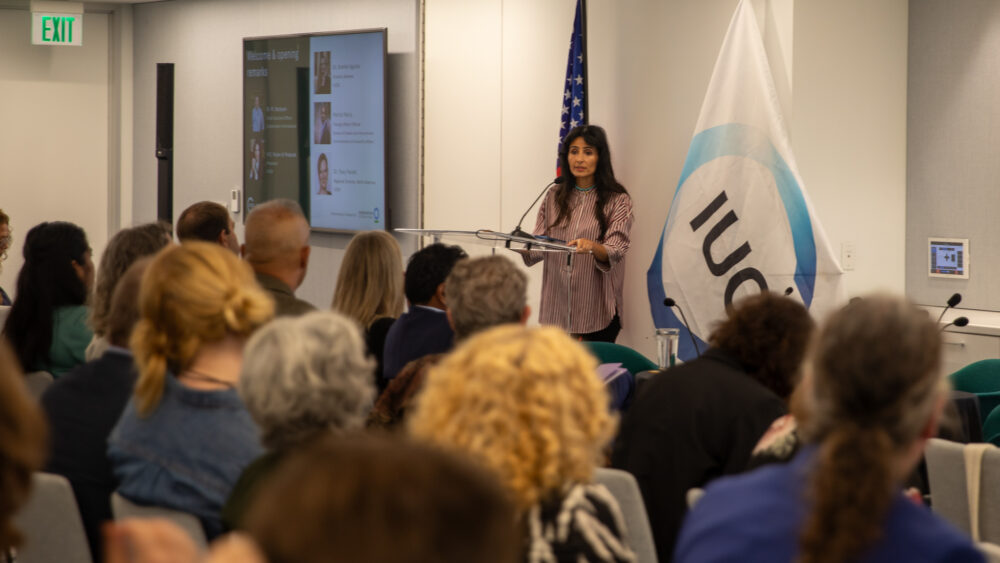We have much more to do and your continued support is needed now more than ever.
Working to Protect Wildlife at the International Climate Change Conference – Part 2

What should the world be doing about climate change?
When most of us think about our changing climate (hotter temperatures, more frequent and more severe storms, sea level rise, etc.) the first things that come to mind – in terms of what’s causing all this – are typically images of large industrial smokestacks and gridlocked superhighways with cars, buses, and trucks spewing out dirty exhaust and other toxic fumes.
But would it surprise you that the land sector (including forest destruction and agriculture) accounts for about 25 percent of global climate change pollution?
During the second week of the United Nations Climate Negotiations (UNFCCC COP 20) in Lima, Peru, discussions about the “land use sector” are heating up. Government negotiators, civil society groups and others involved in the negotiations have been grinding through a debate on how countries should address climate change pollution from the land sector (forest destruction and agriculture).
The land sector is a huge source of emissions, but may also represent one of the keys to successfully reducing this pollution and avoiding some of the more severe climate scenarios that have been predicted by experts. In fact, the land sector may hold some of lowest cost options to address climate change, and this has attracted significant attention from policy makers here in Lima.

Photo Credit: Simon Hall/ NWF
The Importance of the Land Sector in Climate Negotiations
Forests absorb large amounts of dangerous climate change pollution, provide oxygen to the planet, and help maintain rainfall patterns, as well as other critical life support systems for wildlife.
The destruction of forests (primarily caused by the expansion of agriculture – palm oil produced primarily for cooking oils and personal care products, soy produced primarily to feed pigs and chickens, and cattle ranching primarily for beef and leather) has massive environmental consequences. This process whereby forests are cut (and often burned) to create more land for agriculture is a huge source of climate change emissions and large-scale habitat loss.
Iconic tropical bird species, such as the Hyacinth Macaw (commonly known as the “Blue Macaw”), one of the largest parrots in the world, lives in forested regions of South America. These majestic blue macaws are facing massive losses of habitat as large tracts of forests are destroyed to produce food, clothing, and other products that end up on the shelves of stores in the US and Europe (and elsewhere in the world).

NWF’s Work on these Critical Issues
During the second week of the Lima talks, one critical issue for the negotiators has been how to address the land sector (forest destruction and agriculture). National Wildlife Federation co-hosted an official side event (with Union of Concerned Scientists, International Union for Conservation of Nature, Environmental Defense Fund, and Bianca Jagger Human Rights Foundation) on the potential of the land sector to shift from being a major source of emissions to actually helping solve climate change. Ryan Sarsfield (Manager of NWF’s Tropical Forests and Agriculture Project) described opportunities and challenges of improving agricultural production and reducing deforestation to help decrease climate change emissions from the land sector.
The expansion of sustainable agricultural practices in the tropics (particularly for cattle, soy, and palm oil) coupled with stronger efforts to continue to reduce deforestation in the tropics will substantially decrease dangerous climate change pollution from the land sector and help safeguard critical wildlife habitat and biodiversity in these globally important ecological hotspots.
NWF staff (Nathalie Walker, David Burns, Ryan Sarsfield, and Simon Hall) have been working with our NGO partners here in Lima to push countries to recognize the emissions from the land sector and the co-benefits that sustainable forest and agriculture practices can provide for wildlife habitat and biodiversity.
We are hopeful that negotiators will recognize the importance of the land sector and acknowledge that measuring and reducing climate change pollution coming from forests and agriculture can be a cost effective part of the overall solution.
![Panelists and moderator from the NWF, USC, IUCN, EDF and BJHRF official COP side event. Pictured from left to right: Stephan Schwartzman, EDF; Patrick Wylie, IUCN (moderator); Ryan Sarsfield, NWF; and Doug Boucher, USC [not pictured here: Bianca Jagger, BJHRF]. Photo Credit: Simon Hall/ NWF](https://blog.nwf.org/wp-content/blogs.dir/11/files/2014/12/COP-20-Side-Event-Panel-620x250.jpg)






















